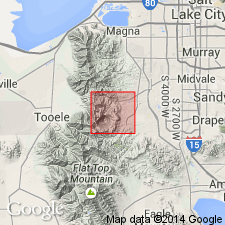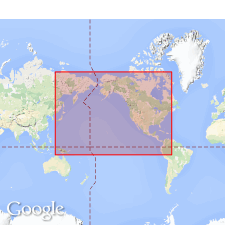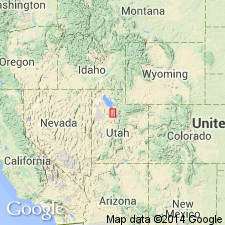
- Usage in publication:
-
- Bingham quartzite*
- Modifications:
-
- Original reference
- Dominant lithology:
-
- Quartzite
- Sandstone
- Limestone
- AAPG geologic province:
-
- Great Basin province
Summary:
Pg. 33-37, map, section. Bingham quartzite. Present in Bingham district, north-central Utah. Chiefly fine-grained quartzites and sandstones, more or less silicified. Mostly white and frequently vitreous. In lower portions of the quartzite, especially below the Jordan limestone, a slight banding is seen in many places, also cross-bedding. In upper part of formation, particularly above Highland Boy limestone, are many layers of ripple-marked argillaceous and slightly calcareous sandstones. In places very thin layers of fine-grained quartz conglomerate occur. Thickness exposed in Bingham district probably 8,000 to 10,000 feet, but neither top nor bottom of formation appears in this district. Is interbedded with many limestone masses, the Tilden limestone lentil, 100 feet; Yampa limestone lentil, 0 to 400 feet; Highland Bay limestone member, 0 to 400 feet; Commercial limestone member, 0 to 200 feet; Jordan limestone member, 20 to 800 feet; Lenox limestone member, 200 feet; Butterfield limestone member, 300 feet. Age of Bingham is Pennsylvanian.
Source: US geologic names lexicon (USGS Bull. 896, p. 189-190).

- Usage in publication:
-
- Bingham quartzite*
- Modifications:
-
- Revised
- AAPG geologic province:
-
- Great Basin province
Summary:
Pg. 348 (B.S. Butler). The important Jordan and Commercial limestones occur in lower part of Bingham quartzite, and the Highland Bay, Yampa, and other limestones possibly considerably higher.
Source: US geologic names lexicon (USGS Bull. 896, p. 189-190).

- Usage in publication:
-
- Bingham Quartzite*
- Modifications:
-
- Overview
- AAPG geologic province:
-
- Great Basin province
Summary:
Bingham Quartzite. Includes following units: Phoenix Limestone Lentil, Tilden Limestone Lentil, Yampa Limestone Lentil, Highland Boy Limestone Member, Commercial Limestone Member, Jordan Limestone Member, Lenox Limestone Member, and Butterfield Limestone Member. Present in Bingham district, north-central Utah. Age is Pennsylvanian.
Source: US geologic names lexicon (USGS Bull. 1200, p. 345).

- Usage in publication:
-
- Bingham Quartzite†
- Modifications:
-
- Abandoned
- AAPG geologic province:
-
- Great Basin province
Summary:
Pg. A5-A8. †Bingham Quartzite. The Bingham Quartzite of Keith (1905, USGS Prof. Paper 38, p. 33-35, pls. 1, 2) is here considered abandoned. It has not been used for many years; workers have applied name Oquirrh Formation (as defined by Gilluly, 1932) to these rocks. Keith (1905) also designated several prominent limestone lentils and members in the Bingham (ascending): Tilden (Petro) and Phoenix Limestone Lentils, and Butterfield, Lenox, Jordan, Commercial, Highland Boy, and Yampa Limestone Members. These names and others used in the mines to designate important ore-forming horizons are abandoned as formally named units and considered local informal marker beds. However, owing to confusion arising from the fact that the Butterfield Limestone Member of Keith (1905) occurs in the "White Pine" Formation of Welsh and James (1961) but not in the Butterfield Formation, the combined unit is here included in the Butterfield Peaks Formation (new) of the Oquirrh Group (fig. 5, section 7).
Source: Publication; Changes in stratigraphic nomenclature, 1970 (USGS Bull. 1354-A, p. A4-A5).
For more information, please contact Nancy Stamm, Geologic Names Committee Secretary.
Asterisk (*) indicates published by U.S. Geological Survey authors.
"No current usage" (†) implies that a name has been abandoned or has fallen into disuse. Former usage and, if known, replacement name given in parentheses ( ).
Slash (/) indicates name conflicts with nomenclatural guidelines (CSN, 1933; ACSN, 1961, 1970; NACSN, 1983, 2005, 2021). May be explained within brackets ([ ]).

